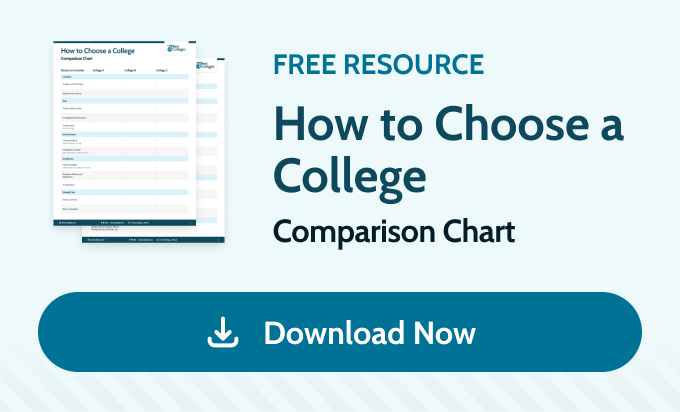How to Choose a College
How do you choose the place you’ll spend years at, explore your interests and passions, and start the journey to your career?
Carefully.
Choosing a college is daunting, but if you approach it well prepared, you’ll end up at the right place. Weigh what’s important to you — including budget, academics, and culture —and see what schools check off the most boxes on your list.
No college is a perfect fit, but the best ones are those you can feel comfortable at and build a community while being challenged academically.
How to Pick the Right College for You
Follow these six steps to help guide you through choosing and applying to the college that fits you best.


Step 1: Consider Your Wants and Needs
Take account of your non-negotiables — your needs— and what would be nice to have. Here’s a list of variables to get you started:
- Location: Do you want to stay close to home or move cross-country? Somewhere in between? If you have a part- or full-time job or a family, an online college may suit you best.
- Budget: Private schools tend to be more expensive than public schools, and in-state schools are often cheaper than out-of-state schools. However, different schools may offer you financial aid that makes some “more expensive” colleges cheaper than others.
- Academics: Is the school well known for what you want to major in? If you don’t know what you want to study, choose colleges with broad selections of majors in science, technology, engineering, and math (STEM); humanities; social sciences; and liberal arts.
- Reputation: Sometimes a good reputation can get you far in your job applications. Is your school well known? Prestigious? Or known in your community? What is the school’s admission rate? Graduation rate?
- Campus culture: What kind of environment do you prefer? Some may seek student bodies that are academically rigorous, diverse, politically active, artistic, party-friendly, or sporty.
Step 2: Create a List of Colleges
It’s a good idea to make a list of schools in a few different categories: safety, target, and reach schools. These should reflect your values in a college and have a mix of some priorities over others.
- Safety: These are schools that you are fairly confident you can get into and can be backups if you don’t get into your target or reach schools.
- Target: These are schools that you have a good chance of getting into. They should balance attainability, cost, environment, academics, and other factors you’re seeking.
- Reach: These schools are academically rigorous and selective, so you have a smaller chance at getting in. Some popular reach schools include the Ivy League or other prestigious schools. Even some out-of-state public universities can be reach schools if they favor in-state students.
Step 3: Visit College Campuses
After you’ve created your list of schools, try visiting some schools in each category. Sometimes a school can look great on paper, but it might have a different vibe on campus, so it’s good to keep an open mind.
You can book a university-official tour, go with your friends and family, or link up with a friend who goes to the university to see the campus culture and study and living spaces for yourself. If the school is farther away and more difficult to visit, you can always start with an online tour.
Step 4: Apply to Colleges
Once you’ve narrowed down your list, it’s a good idea to apply to at least 5-10 schools. Typically, you’ll have until May 1 to decide on a school. There’s a few ways you can apply:
- Early Action: This is a nonbinding (you don’t have to accept an offer) college application that gets you an answer from colleges the soonest.
- Early Decision I and II: This is a binding decision where you must agree to attend that school if accepted.
- Regular Decision: A nonbinding college application after early action.
- Rolling Admissions: You can apply at almost any time of the year and receive a response from your college as soon as they receive your application and review it.
Some common things you’ll need to include in your applications are:
- Official transcripts from every high school and college you have attended
- SAT or ACT scores (While many schools made the SAT and ACT tests optional during the COVID-19 pandemic, more schools are asking students to take the exams once again.)
- 1-3 letters of recommendation
- Personal statement
Step 5: Compare Financial Aid Offers
Once you get your offers back, compare each school’s financial aid package to see where the best bang for your buck is.
See what schools offer the best grant and scholarship aid, which you won’t have to pay back. Remember, if you take out student loans, you’ll have to pay those back with interest.
You also may be eligible for ” Work-study jobs are part-time jobs offered by the university where you can earn some money with flexible hours to pay for tuition and fees, books, or other living expenses.
Step 6: Make a Pros and Cons List
Now you’re at the final step, making the college decision. Write down all the pros and cons for the schools you were accepted to. Here are a few things to compare:
- The largest financial aid offers
- What you learned from visiting some campuses
- The culture at the school
- How far the school is from home
- The majors offered at the school
Frequently Asked Questions About Picking a College
A few important factors to consider are location, budget, academics, culture, and reputation. Ask yourself what you’re looking for in each of these categories and weigh them to see what you prioritize and what you can compromise on.





